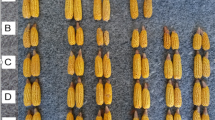Abstract
Field experiments were conducted for two seasons to assess the efficacy of the entomopathogenic fungus Metarhizium anisopliae in the control of termites in maize. Application of the fungus at planting was found to significantly reduce maize lodging and increase grain yield in both seasons. However, data from treatment application at tasselling were not consistent. Our results suggest that a granular formulation of M. anisopliae might be a useful option for the management of termites in the maize agroecosystem.
Résumé
Des expérimentations en plein champs ont été conduites durant deux saisons afin d’évaluer l’efficacité du champignon entomopathogène Metarhizium anisopliae pour la lutte contre les termites sur les cultures de maïs. L’application du champignon au moment de la semis s’est révélée très efficace en réduisant la chute des plants de maïs d’une part, et en augmentant le rendement en grains d’autre part, pendant les deux saisons. Cependant, les résultats issus des traitements pendant l’inflorescence des plants de maïs n’étaient pas consistants. Nos résultats suggèrent donc que la formulation du champignon M. anisopliae en granules serait une option appropriée pour le contrôle des termites dans les cultures de maïs.
Similar content being viewed by others
References
Abdulrahman A. (1990) Foraging activity and control of termites in western Ethiopia, PhD thesis, University of London, 277 pp.
Booth S. R., Tanigoshi L. and Dewes I. (2000) Potential of a dried mycelium formulation of an indigenous strain of Metarhizium anisopliae against subterranean pests of cranberry. Biocontrol Sci. Technol. 10, 659–668.
Cowie R. H. and Wood T. G. (1989) Damage to crops, forestry and range-land by fungus-growing termites (Termitidae: Macrotermitinae) in Ethiopia. Sociobiology 15, 139–153.
Dent D. (1999) Green Muscle® registered in South Africa. Biol. News Inf. 20, 9N.
EcoScience (1997) Bio-Blast™ biological termiticide. https://doi.org/www.ecoscience.com/bioblas/bio-blas.html.
Fernandes P.M. and Alves S.B. (1991) Control of Cornitermes cumulans (Kollar 1832) (Isoptera: Termitidae) with Beauveria bassiana (Bals.) Vuill. and Metarhizium anisopliae (Metsch.) Sorok. under field conditions. Ann. Entomol. Soc. Brazil 20, 45–50.
Gethi M., Gitonga W. and Ochiel G. R. S. (1995) Termite damage and control options in eastern Kenya. In Proceedings of 2ndRegional Workshop on Termite Research and Control, 7–9 March 1995, Nairobi, Kenya.
Gitonga W. (1992) Termicidal screening and assessment of termite damage in agriculture and forestry in Kenya. In Proceedings 1st Regional Workshop on Termite Research and Control, 17–19 August 1990, Nairobi, Kenya.
Gitonga W. (1996) Metarhizium anisopliae (Metschnikoff) Sorokin and Beauveria bassiana (Balsamo) Vuillemin as potential biological control agents of Macrotermes michaelseni (Sjostedt) (Isoptera: Termitidae) in Kenya. PhD thesis. Royal Veterinary and Agricultural University, Copenhagen, Denmark.
ICIPE (1997) Annual Scientific Report, 1995–1997, International Centre of Insect Physiology and Ecology, Nairobi, Kenya.
Ko W. H., Fuji J. K. and Kanegawa K. M. (1982) The nature of soil pernicious to Coptotermes formosanus. J. Invertebr. Pathol. 39, 38–40.
Krueger S. R., Villani M. G., Martins A. S. and Roberts D. W. (1992) Efficacy of soil application of Metarhizium anisopliae (Metsch.) Sorokin conidia, and standard and lyophilized mycelial particles against scarab grubs. J. Invertebr. Pathol. 59, 54–60.
Logan J. W. M., Cowie R. H. and Wood T. G. (1990) Termite (Isoptera) control in agriculture and forestry by nonchemical methods: A review. Bull. Entomol. Res. 80, 309–330.
Milner R. J. and Staples J. A. (1996) Biological control of termites—results and experiences within a CSIRO project in Australia. Biocontrol Sci. Technol. 6, 3–9.
Nkunika O. Y. P. (1999) Potential use of entomopathogenic fungi for the control of termites in cassava fields, pp. 263–268. In Proceedings of the First Scientific Workshop of the Southern African Root Crops Research Network (SARRNET) (Edited by M. O. Akoroda and J. M. Teri), Zambia.
Ochiel G. R. S., Gitonga W. and Kusewa T. M. (1995) Comparison of chemical and cultural treatments against termites (Isoptera: Termitidae) in western Kenya. In Proceedings, 2nd Regional Workshop on Termite Research and Control, 7–9 March 1995, Nairobi, Kenya.
Polaszek A. (Ed.) (1998) African Cereal Stem Borers: Economic Importance, Taxonomy, Natural Enemies and Control. CAB International, Oxon, 530 pp.
Prior C. (1988) Biological pesticides for low external-input agriculture. Biol. News Info. 10, 17–22.
Rath A. C. (2000) The use of entomopathogenic fungi for termite control. Biocontrol Sci. Technol. 10, 563–581.
Sands W. A. (1977) The role of termites in tropical agriculture. Outlook Agric. 9, 136–143.
SAS Institute (1990) SAS/STAT User’s Guide, Version 6, 4th Edition, Vol. 2. SAS Institute, Cary, NC.
Sekamatte M. B. (2000) Options for integrated management of termites (Isoptera: Termitidae) in smallholder maize-based cropping systems in Uganda. PhD thesis submitted to Makerere University, Uganda.
Umeh V. C. and Ivbijaro M. F. (1997) Termite abundance and damage in traditional maize-cassava intercrops in southwestern Nigeria. Insect Sri. Applic. 17, 315–321.
United Nations (1987) Consolidated List of Products Where Consumption and/or Sale Have Been Banned, Withdrawn, Severely Restricted or Not Approved by Governments. New York, United Nations (United Nations Publ. ST/ESA/192).
Wightman J. A. (1991) Soil insect problem in African groundnut crops, pp. 171–176. In Advances in Management and Conservation of Soil Fauna (Edited by G.K. Veeresh, D. Rajagopal and C.A. Viraktamath). Oxford/IBH Publ., New Delhi.
Wood T. G. (1986) Report on a visit to Ethiopia to advise on assessment of termite damage to crops. Report R1347 (R). ODNRI, London.
Wood T. G., Bednarzik M. and Aden H. (1987) Damage to crops by Microtermes najdensis (Isoptera, Macrotermitinae) in irrigated semi-desert areas of the Red Sea coast. 1. The Tihama region of the Yemen Arab Republic. Trop. Pest Manage. 33, 142–150.
Wood T. G., Johnson R. A. and Ohiagu C. E. (1980) Termite damage and crop loss studies in Nigeria—A review of termite damage to maize and estimation of damage, loss of yield and Microtermes abundance at Mokwa. Trop. Pest Manage. 26, 241–253.
Author information
Authors and Affiliations
Corresponding author
Rights and permissions
About this article
Cite this article
Maniania, N.K., Ekesi, S. & Songa, J.M. Managing Termites in Maize with the Entomopathogenic Fungus Metarhizium anisopliae. Int J Trop Insect Sci 22, 41–46 (2002). https://doi.org/10.1017/S1742758400015046
Accepted:
Published:
Issue Date:
DOI: https://doi.org/10.1017/S1742758400015046




